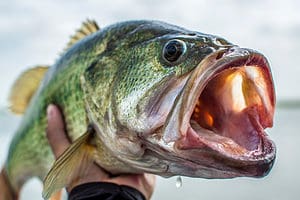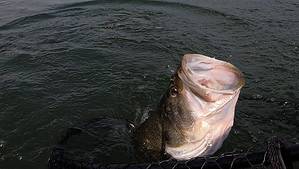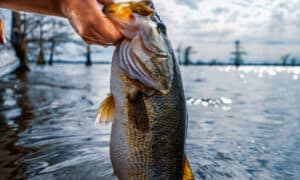The striped bass (Morone saxatilis) is hard-fighting sport fish that is a favorite among anglers. It is an anadromous fish, meaning it spends most of its adult life at sea but moves into freshwater to spawn. The fish’s tolerance of both salt and freshwater has led to striped bass stocking far beyond its native range. It is also an important factor when considering the sizes that striped bass (commonly known as stripers) can reach.

Striped bass are a favorite among anglers.
©Pelow Media/Shutterstock.com
Striped Bass Sizes
Landlocked stripers typically do not grow as large as the stripers that have access to the ocean. The average saltwater striped bass weighs 10-20 pounds, while the average landlocked striper weighs 5-10 pounds. Stripers can grow far larger than these average weights, though.
Because of the weight differences between landlocked and saltwater striped bass, the International Game Fish Association (IGFA) has created two separate world record categories. The world record landlocked striped bass weighed 69 pounds, 9 ounces. James R. Bramlett caught the record-breaking fish on February 28, 2013, on the Black Warrior River in Alabama.
The world record saltwater striped bass weighed 81 pounds, 14 ounces. Gregory Myerson caught the massive striper on the Long Island Sound in Westbrook, Connecticut, on August 4, 2011.
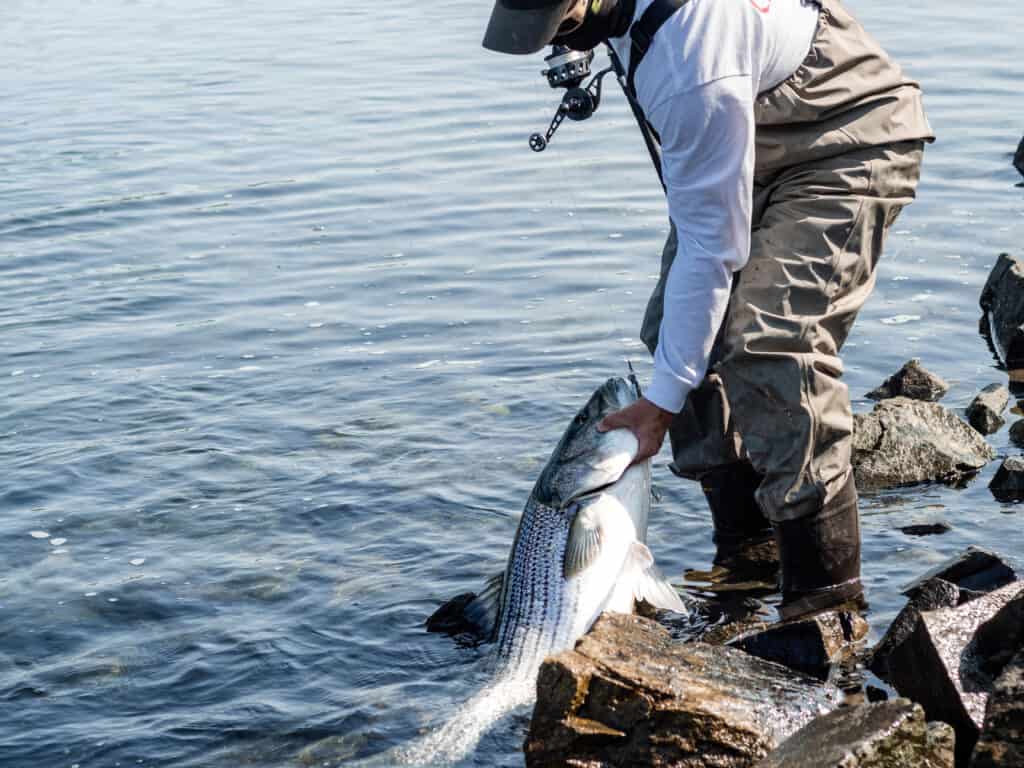
Stripers are large sport fish that put up quite a fight!
©Tfreeman_Films/Shutterstock.com
Both records are fairly recent, and both stand a good chance of being broken someday, with the saltwater record being the more likely one to fall. Far larger stripers have been caught in the ocean with nets. The IGFA record only reflects stripers caught with a rod and reel.
In 1995, scientists caught a striped bass in a net in the Chesapeake Bay that weighed 92 pounds. But the biggest striper on record dates back more than 100 years prior to that catch.
In 1892, two commercial fishermen from North Carolina netted a striped bass that weighed 125 pounds.
Given these numbers, it seems like a matter of time before a new rod-and-reel striper record is set.
Striped Bass Range
The striped bass’ native range extends along the east coast of North America, from the St. Lawrence River in Canada to the St. John’s River in Florida, and into the Gulf of Mexico from Florida to Louisiana.
The fish have been introduced into the Pacific waters and are now found from British Columbia to Mexico.
They have also been stocked in many inland lakes and reservoirs.
Landlocked Stripers
The first documented landlocked striped bass was in South Carolina in the 1950s. The dams that were built as part of the Santee-Cooper Project created this unintended consequence. Large fish started breaking anglers’ lines in Lake Moultrie and Lake Marion. Some suggested they were large catfish or possibly huge largemouth bass, but the culprits were actually striped bass that had become trapped by the dams. The fish thrived in the freshwater environment. The news set the sport fishing world abuzz, and it led to striped bass stocking in impoundments all over the U.S.
Striped Bass Appearance
The striped bass has a silvery body that transitions to olive green along the back and white on the belly. The fish’s name comes from the seven or eight stripes along both sides of its body. The dorsal fin has both spiny and soft-rayed sections.
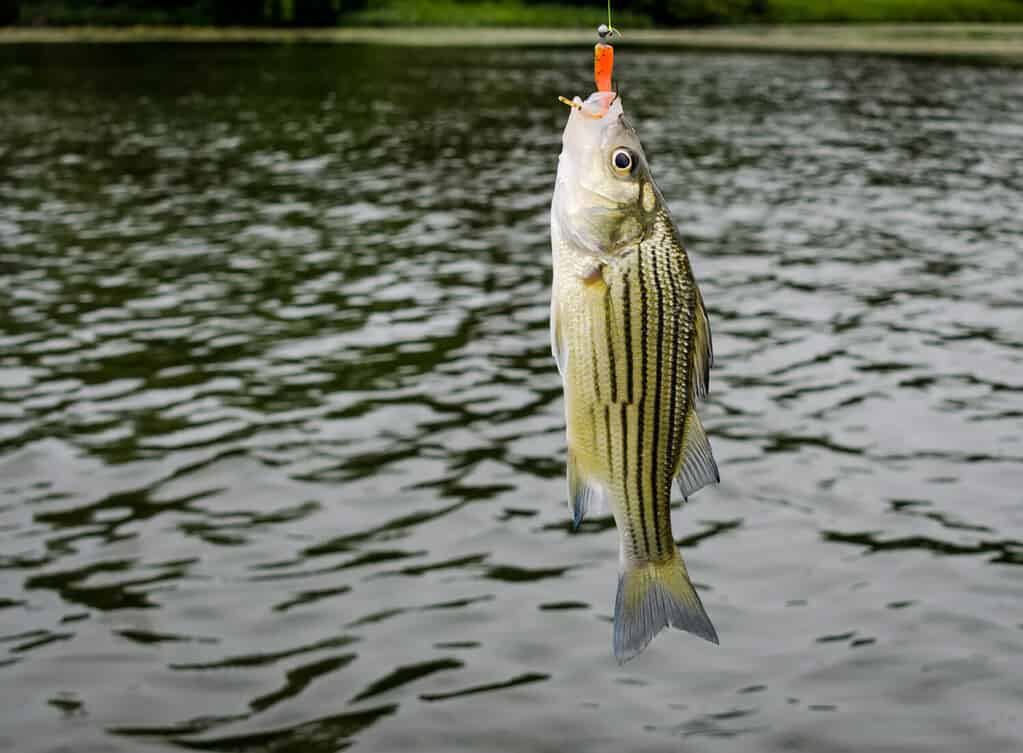
Striped bass takes their name from the longitudinal lines along the sides of their bodies.
©HildeAnna/Shutterstock.com
True Bass
The striped bass is a temperate bass, also known as a true bass. Several fish species that bear the “bass” name are not true bass. Largemouth, smallmouth, and rock bass are not true basses but rather are members of the sunfish family Centrarchidae. The same family includes popular panfish species such as bluegill, crappie, pumpkinseed, and others.
The true basses are in the family Moronidae. They include the striped, white, and yellow bass and the white perch (sometimes called the silver bass).

The largemouth bass is actually a sunfish, not a true bass.
©iStock.com/stammphoto
Hybrid Striped Bass
A fifth fish in the true bass family is a hybrid of striped and white bass. The hybrid striped bass is colloquially known as the “wiper,” combing the white bass and striper names. While these fish can hybridize naturally, fishery management agencies produce and stock many hybrid stripers.
The first hybrid striped bass were stocked in Cherokee Lake in Tennessee in the 1970s. Some anglers still refer to the fish as Cherokee bass, regardless of where it is located.
Hybrid striped bass do not reach the same size as full-blooded stripers. The world record hybrid striped bass weighed 27 pounds, 5 ounces. Jerald C. Shaum caught the fish on Greers Ferry Lake in Arkansas on April 24, 1997.

Hybrid striped bass are popular sport fish easy to find in many inland reservoirs.
State Fish
The striped bass is the official state fish of Maryland, Rhode Island, and South Carolina. It is the state marine (saltwater) fish of New Hampshire, New Jersey, New York, and Virginia.
The photo featured at the top of this post is © slowmotiongli/Shutterstock.com
Thank you for reading! Have some feedback for us? Contact the AZ Animals editorial team.




